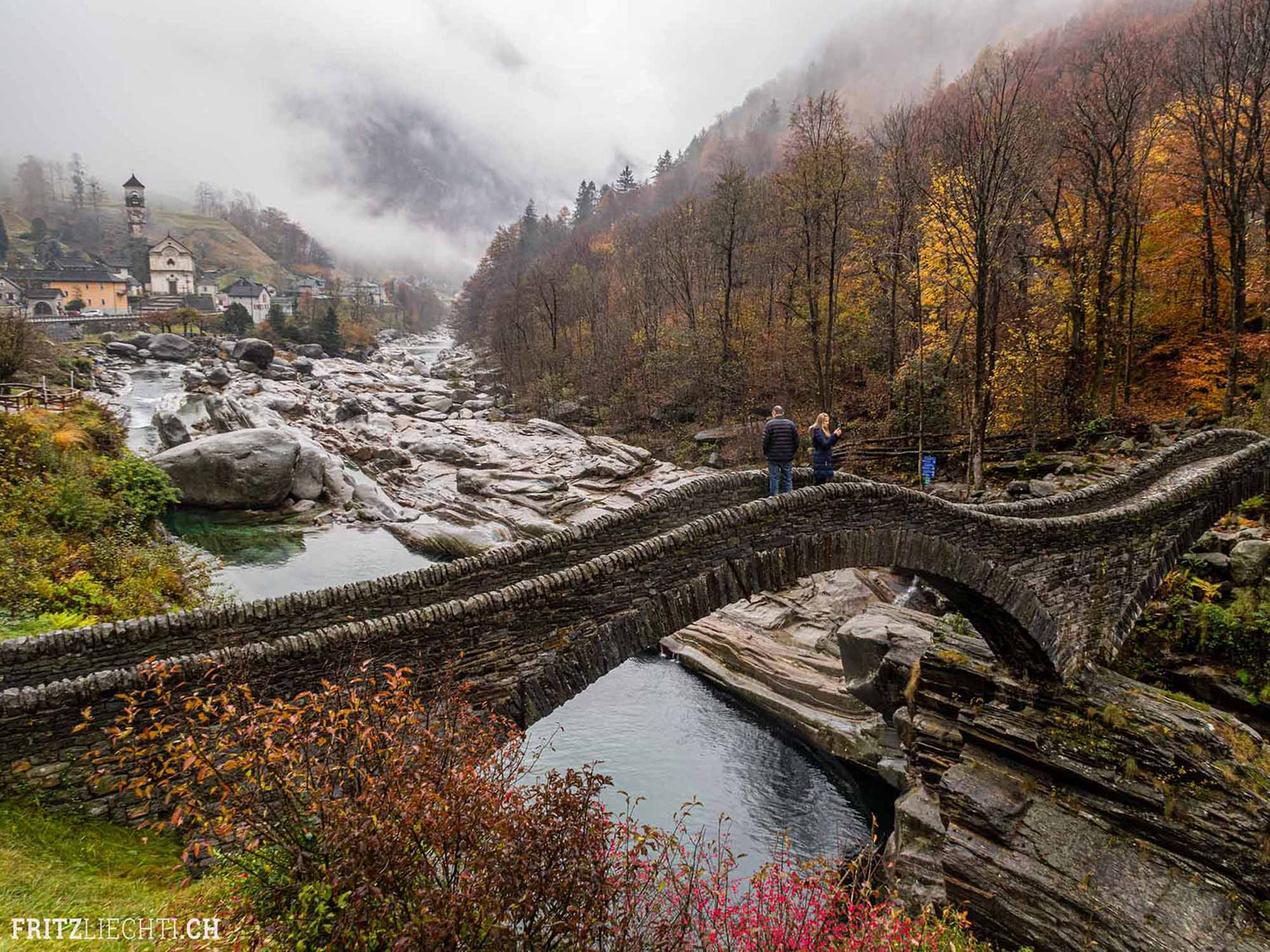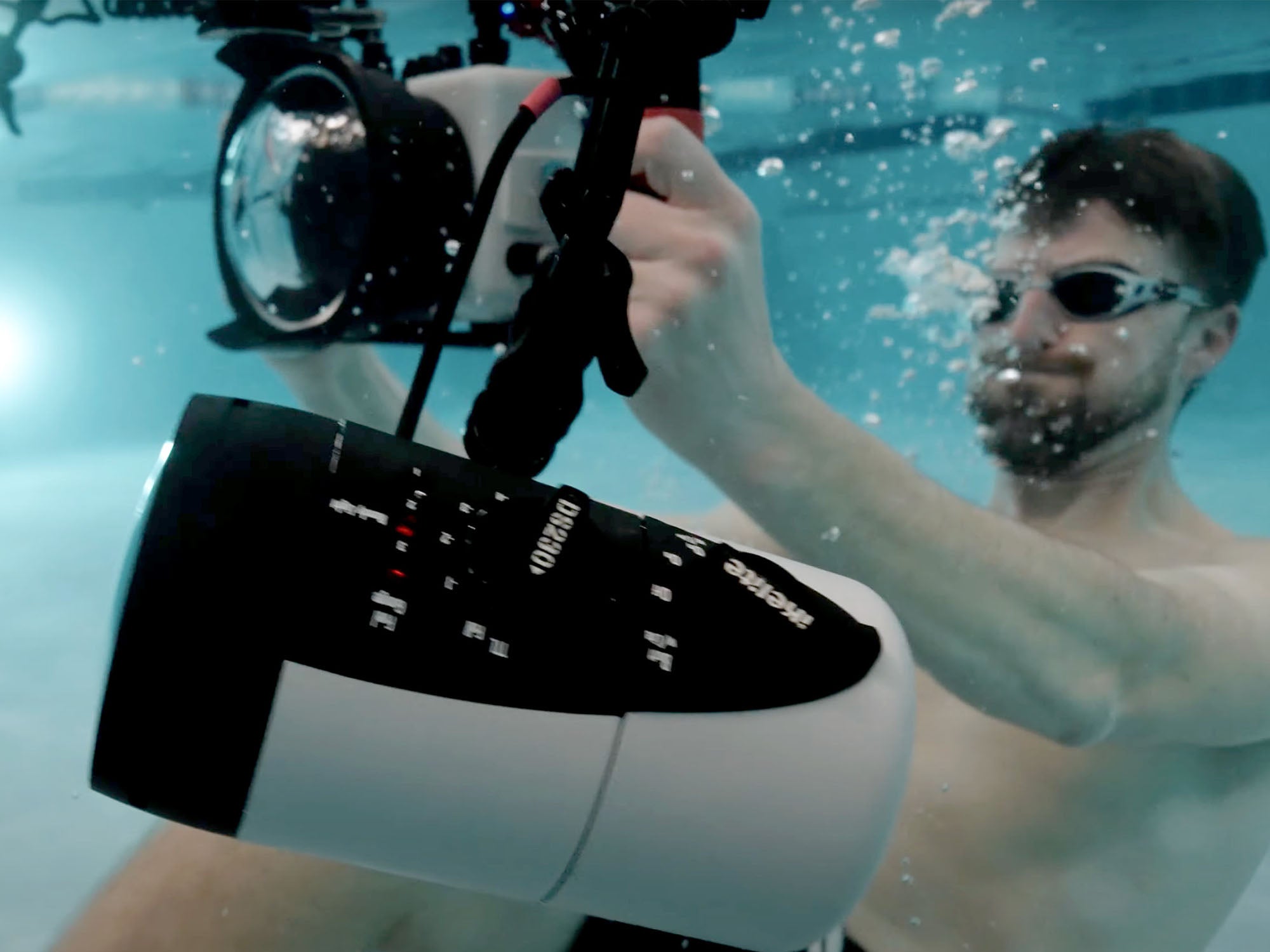By Fritz Liechti
All images © Fritz Liechti
Well – I’m a bit crazy. I love diving in rivers, all the year over (if nature is with me and there is not too much rain before or too much snow on the rocks) and I dive there with my buddies more at night than in daytime. Why do adult guys and girls do such a thing?

Much of current in the Verzasca river, right behind a small waterfall. In the canyons the situation changes every few meters. River diving is not for couch-potatoes.
Here in Switzerland we have a lot of small creeks, big rivers, ponds and deep lakes. So we have a lot of opportunities to dive somewhere. Getting older I don’t need every week a deep dive of 40m (131.2ft) at a rock wall going down to 100m (328ft) in a lake. Taking pictures in rivers is much more fun and you can do it longer, it’s mostly only 10m (32.8ft) deep. As we still have to earn our money during daytime we go scuba diving in the evening, when it’s getting dark and mystic.

A pike in the Rhine river - large and majestic. They have a wonderful colour and reflection. In the river I can get to them much easier than in the lake.
In rivers you can see much more life than in the lake. Provided that the water is absolutely clean and no sewage flows into it (it's absolutely forbidden in Switzerland). Trout and barbel need oxygen-rich water and are mostly in fast running part of a river. Pike, catfish and perch are everywhere. Carp, tench and small fish like rather calm waters. So you can find a suitable water for diving in all areas. Provided that diving there is allowed by the authorities at all.
Diving in the midland in the bigger rivers
I love diving in the Aare River. In autumn, when it hasn't rained for some time, just below a power plant, or then about half a kilometer below the power plant in and after 2.5km (1.55miles) after a drift dive out again (you will need two cars, otherwise you walk).
Below the plant it has extremely strong current. But we know the terrain very well. Here is the Eldorado of fish. Everything wants to go up, the big ones have their territories. This is hardcore photography at a flow speed of 2m/s (6.56ft/s) is like shooting clay pigeons. After 300m (984.2ft) the river slows down.

Pikes are usually solitary. But when there is so much food under the power plant, you can find a large quantity. The biggest ones there are about 150cm (4.9ft).
Driftdive to the catfish
Big catfish often live in families and have their territory. There photographing is a little easier than in the super fast current, but you are still on a drift dive of 0.8m/s (2.6ft/s). You see in the dark a catfish, focus, shoot several photos and you are behind it. Stopping is impossible. The big catfish there are between 2 - 3m long (much bigger than me) and I've had a collision several times with one of them, because the catfish and I also swerved to the same side when crossing. Catfishes are harmless and only shake their heads at the highest about the idiot with the camera that can't properly swim.

Catfish grow up to 3m (9.8ft) in size. They are the largest predatory fish in our waters - and there are more and more of them. We don't have sharks, so I love to photograph them.
When taking photos, a wide angle and servo AF with a larger AF area is a must. My DS230 Strobes help me enormously now. Finally, I can shoot series of a suddenly appearing fish at night even during a fast drift dive. Without correct TTL you have no chance to get well exposed pictures. The main problem, however, are the floating parts, which you release yourself at the bottom of the river with your fins and which swim then along with you.
Diving in the Rhine river near the old toll bridge (border Switzerland - Germany)
Well, under water there are no customs officers, and I don’t need a passport. I love it there, as it has bizarre rock formations and catfish. In autumn there are so many different species of fishes.

The bridge was mentioned for the first time in 1324 in books of the Rheinau monastery. In 1806 it was built in its present form as a wood bridge. In 1988, the current piers were installed in steel.

In clear water the bridge gives a cool silhouette in the evening sun. In freshwater the colours always turn to green. Unfortunately, my buddy once again chased a fish and I had no model for the picture.

The old bridge piers from below. My buddy came back after all and wanted to earn a beer after diving. Well, the sun was already down. You have all the time some issues with your models! There are so many good motifs in the river.
Verzasca River - the supreme discipline for river divers in the mountains
In the Italian-speaking part of the Swiss Alps, the Verzasca river is the most beautiful and clearest river of all. Unfortunately, it is also the deadliest, as people drown in the rapids every year - divers included. Only experienced divers with river training should dive there. Safety ropes must be stretched as a "red line" with markers, that you see properly where to go out. Behind this line, even the strongest swimmer has no chance in the rapids.

The Verzasca is a wild mountain stream. Already in Roman times there was a similar stone bridge over the river. The bridge was restored to its present form in 1960. It is the tourist attraction in the region.
Diving with a camera against the current is not easy, but there are current shadows everywhere and in deeper pools you can dive comfortably. The underwater world is magnificent. The granite is smoothly polished and clean. After a high water all stones are sparkling clean and the quartz shimmers. Sand, algae, plants etc. are almost non-existent here. But the diving is exhausting. Sometimes all the material has to be brought to the water by climbing over mountain paths or by using ladders.

Diving in autumn under the stone bridge after a flood. The granite and gravel were cleaned as if by magic. Visibility to 50m (164ft). As a photographer you don't want to leave the water. Well - the water is really cold. At some point you need something warm, or a strong drink.

100m (328ft) below the bridge there is another diveable canyon. The huge glacier mill in the granite shows the power of water and ice during several millennia. As photographers we are privileged to see these natural wonders up close.

And a pond in the Verzasca river. So much fun diving there. OK, I hated lugging my stuff down to the water. Why is diving gear and photo equipment so heavy?
Dive in!
Guys - just a tip. Be crazy too! There are certainly ponds and rivers in your area that can be explored (if there are no alligators, snakes and other unfriendly animals in them- I’m afraid of them). It doesn't always have to be a trip to the Maldives, Indonesia, or the Caribbean. There are pearls in nature everywhere, where you just must stick your camera in! Just be curious around your hometown. Every dive trip will be a big adventure. And if it’s boring, take a beer and try the next one.
Photography
Mostly I use a Canon 15-30mm, a 17-40mm or a 8-15mm lens. With 8mm, the fish often look too small, or too far away. A fast autofocus, Tv with a minimum of 1/160s in servo mode (you yourself move fast in the current), a focus light and a strobe that can shoot very fast series (the DS230 is just a monster, I need to sell sunglasses to our fish). Meanwhile I also dive with an external monitor. I don't have to look through the 45° viewfinder anymore and am much faster at composition of the photo, but unfortunately the resistance in the current is bigger. Important for river diving is the pre-programming of the “Custom Shooting Mode” (Canon C1-C3). So, the complete setting can be changed in seconds.
Tips for photography in rivers
- Your buoyancy must be correct. Balance slightly negative over the bottom, the rest you do with the lungs. At night I still hold the diving lamp in my left hand to look for fish. The camera is in the right. Changing buoyancy all the time with your jacket - not possible, humans simply have too few hands.
- The camera must have a slightly positive buoyancy. When I let go of it, it must not crash into the rocks.
Important
- River diving is only for experienced and trained divers. In Switzerland, divers are very seriously prepared for this by CMAS in special courses.
- In larger rivers there is danger from boat traffic.
- In fast flowing waters there is a danger of getting stuck in trees and other obstacles.
- On your first dive you should explore the water without a camera to be on the safe side.
 Fritz Liechti of Switzerland started diving in 1986 and rarely goes into the water without a camera. He particularly enjoys diving in Switzerland's rivers, especially at night. He travels the world and teaches underwater photography as a CMAS (World Confederation of Underwater Activities) Diving and Underwater Photo Instructor. He has had his work published in several magazines and represented Switzerland in the 2019 CMAS Underwater Photo World Championships. See more of his work at www.fritzliechti.com
Fritz Liechti of Switzerland started diving in 1986 and rarely goes into the water without a camera. He particularly enjoys diving in Switzerland's rivers, especially at night. He travels the world and teaches underwater photography as a CMAS (World Confederation of Underwater Activities) Diving and Underwater Photo Instructor. He has had his work published in several magazines and represented Switzerland in the 2019 CMAS Underwater Photo World Championships. See more of his work at www.fritzliechti.com
Additional Reading
Photographing the Salmon Run Underwater in Canada
Customer Photos | Fritz Liechti from the Fresh Water of Switzerland
Freshwater Underwater Camera Settings and Technique












![Custom White Balance for Underwater with Canon Mirrorless Cameras [VIDEO]](http://www.ikelite.com/cdn/shop/articles/manual-wb-cover.jpg?v=1676591383&width=2001)
